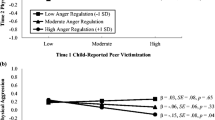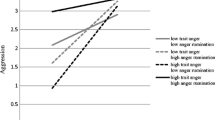Abstract
This study examined associations between victimization by peers and intention to respond to provocative events as a function of anger arousal and motivation to improve the situation in a cross-sectional sample of school-age children (N = 506, 260 males, 246 females). Results demonstrated that more intense anger and more retaliatory motivation were positively associated with intentions to aggress and with frequency of victimization. The association between aggressive intentions to respond to anger provocation and victimization could be accounted for by subjective feelings of anger and motivation to retaliate. The contribution of emotion processes was stronger for boys than for girls. A post hoc examination of non-bullying participants revealed that motivation accounted for aggressive intentions among the non-bullies. Results support including anger management programs in prevention efforts that target the school climate andvictims’ risk for psychopathology.
Similar content being viewed by others
References
Olweus D (1993) Bullying at school: what we know and what we can do. Blackwell, Cambridge, MA
Coie JD, Dodge KA (1998) Aggression and antisocial behavior. In: Damon W, Eisenberg N (eds) Handbook of child psychology: Vol. 3. Social, emotional, and personality development, 5th edn. Wiley, New York, pp 779–862
Crick NR, Bigbee MA (1998) Relational and overt forms of peer victimization: a multiinformant approach. J Consult Clin Psychol 66:337–347
Batsche GM, Knoff HM (1994) Bullies and their victims: understanding a pervasive problem in the schools. School Psych Rev 23:165–174
Farrington DP (1993) Understanding and preventing bullying. In: Tonry M (ed) Crime and justice: a review of research: Vol. 17. An annual review of research. University of Chicago Press, Chicago, pp 381–458
Harachi TW, Catalano RF, Hawkins D (1999) United States. In: Smith PK, Morita Y, Junger-Tas J, Olweus D, Catalano R, Slee P (eds) The nature of school bullying: a cross-national perspective. Routledge, New York, pp 1–4
Nansel TR, Overpeck M, Pilla RS, Ruan WJ, Simons-Morton B, Scheidt P (2001) Bullying behaviors among US youth: prevalence and association with psychosocial adjustment. JAMA 285:2094–2100
Cicchetti D (1993) Developmental psychopathology: reactions, reflections, projections. Dev Rev 13:471–502
Barrett KC (1998) A functionalist perspective to the development of emotions. In: Mascolo MR, Griffin S (eds) What develops in emotional development? Plenum Press, New York, pp 109–133
Campos JJ, Frankel CB, Camras L (2004) On the nature of emotion regulation. Child Dev 75:377–394
Diamond LM, Aspinwall LG (2003) Integrating diverse developmental perspectives on emotion regulation. Motiv Emotion 27:1–6
Cicchetti D, Ackerman BP, Izard CE (1995) Emotions and emotion regulation in developmental psychopathology. Dev Psychopathol 7:1–10
Izard CE, Ackerman BP, Schoff KM (2000) Fine SE self-organization of discrete emotions, emotion patterns, and emotion-cognition relations. In: Lewis MD, Granic I (eds) Emotion, development, and self-organization: dynamic systems approaches to emotional development. Cambridge University Press, New York, pp. 15–36
Campos JJ, Campos RG, Barrett KC (1989) Emergent themes in the study of emotional development and emotion regulation. Dev Psychol 25:394–402
Izard CE (1993) Organizational and motivational functions of discrete emotions. In: Lewis M, Haviland JM (eds) Handbook of emotions. Guilford Press, New York, pp 631–641
Saarni C (1999) The development of emotional competence. Guilford Press, New York
Frijda N (1986) The emotions. Cambridge University Press, Cambridge, UK
Murphy BC, Eisenberg N (1996) Provoked by a peer: children’s anger-related responses and their relations to social functioning. Merrill-Palmer Q 42:103–124
Arsenio WF, Cooperman S, Lover A (2000) Affective predictors of preschoolers’ aggression and peer acceptance: direct and indirect effects. Dev Psychol 36:438–448
Kochenderfer-Ladd B (2004) Peer victimization: the role of emotions in adaptive and maladaptive coping. Soc Dev 13:329–349
Hubbard JA, Parker EH, Ramsden SR, Flanagan KD, Relyea N, Dearing KF et al (2004) The relations among observational, physiological, and self-report measures of children’s anger. Soc Dev 13:14–39
Parker EH, Hubbard JA, Ramsden SR, Relyea N, Dearing KF, Smithmyer CM et al (2001) Children’s use and knowledge of display rules for anger following hypothetical vignettes versus following live peer interaction. Soc Dev 10:528–557
Underwood MK, Bjornstad GJ (2001) Children’s emotional experience of peer provocation: the relation between observed behaviour and self-reports of emotions, expressions, and social goals. Int J Behav Dev 25:320–330
Fabes RA, Eisenberg N (1992) Young children’s coping with interpersonal anger. Child Dev 63:116–128
Eisenberg N, Guthrie IK, Fabes RA, Reiser M, Murphy BC, Holgren R et al (1997) The relations of regulation and emotionality to resiliency and competent social functioning in elementary school children. Child Dev 68:295–311
Knight GP, Guthrie IK, Page MC, Fabes RA (2002) Emotion arousal and gender differences in aggression: a meta-analysis. Aggress Behav 28:366–393
Hubbard JA, Smithmyer CM, Ramsden SR, Parker EH, Flanagan KD, Dearing KF et al (2002) Observational, physiological, and self-report measures of children’s anger: relations to reactive versus proactive aggression. Child Dev 73:1101–1118
Averill JR (2002) Anger and aggression: an essay on emotion. Springer-Verlag, New York
Averill JR (1983) Studies on anger and aggression: implications for theories of emotion. Am Psychol 38:1145–1160
Hanish LD, Eisenberg N, Fabes RA, Spinard TL, Ryan P, Schmidt S (2004) The expression and regulation of negative emotions: risk factors for young children’s peer victimization. Dev Psychopathol 16:335–353
Shields A, Cicchetti D (2001) Parental maltreatment and emotion dysregulation as risk factors for bullying and victimization in middle childhood. J Clin Child Psychol 30:349–363
Hodges EVE, Perry DG (1999) Personal and interpersonal antecedents and consequences of victimization by peers. J Pers Soc Psychol 76:677–685
Perry DG, Kusel SJ, Perry LC (1988) Victims of peer aggression. Dev Psychol 24:807–814
Schwartz D, Dodge KA, Coie JD (1993) The emergence of chronic peer victimization in boys’ play groups. Child Dev 64:1755–1772
Champion K, Vernberg E, Shipman K (2003) Nonbullying victims of bullies: aggression, social skills, and friendship characteristics. J Appl Dev Psychol 24:535–551
Pellegrini AD, Bartini M, Brooks F (1999) School bullies, victims, and aggressive victims: factors relating to group affiliation and victimization in early adolescence. J Educ Psychol 91:216–224
Poulin F, Boivin M (2000) Reactive and proactive aggression: evidence of a two-factor model. Psychol Assess 12:115–122
Vernberg EM, Jacobs AK, Hershberger SL (1999) Peer victimization and attitudes about violence during early adolescence. J Clin Child Psychol 28:386–395
Salmivalli C, Nieminen E (2002) Proactive and reactive aggression among school bullies, victims, and bully-victims. Aggress Behav 28:30–44
Maccoby EE, Jacklin CN (1980) Sex differences in aggression: a rejoinder and reprise. Child Dev 51:964–980
Tangney JP, Becker B, Hill-Barlow D (1996) Gender differences in constructive vs. destructive responses to anger across the lifespan. Unpublished manuscript, George Mason University, Fairfax, Virginia
Aber JL, Brown JL, Jones SM (2003) Developmental trajectories toward violence in middle childhood: course, demographic differences, and response to school-based intervention. Dev Psychol 39:324–348
Zeman J, Garber J (1996) Display rules for anger, sadness, and pain: it depends on who is watching. Child Dev 67:957–973
Tangney JP, Hill-Barlow D, Wagner PE, Marschall DE, Borenstein JK, Sanftner J et al (1996) Assessing individual differences in constructive versus destructive responses to anger across the lifespan. J Pers Soc Psychol 70:780–796
U.S. Census Bureau. State and county quickfacts: Brown County, Minnesota [Internet]. Available at: http://quickfacts.census.gov/qfd/states/27/27015.html. Accessed Feb 1, 2002
Grotpeter JK, Crick NR (1996) Relational aggression, overt aggression, and friendship. Child Dev 67:2328–2338
Crick NR, Grotpeter JK (1995) Relational aggression, gender, and social–psychological adjustment. Child Dev 66:710–722
Aiken LS, West SG (1991) Multiple regression: testing and interpreting interactions. Sage, Newbury Park, CA
Baron RM, Kenny DA (1986) The moderator–mediator variable distinction in social psychological research: conceptual, strategic and statistical considerations. J Pers Soc Psychol 51:1173–1182
Perry DG, Williard JC, Perry LC (1990) Peers’ perceptions of the consequences that victimized children provide aggressors. Child Dev 61:1310–1325
Preacher KJ, Leonardelli GJ. Calculation for the Sobel test: an interactive calculation tool for mediation tests [Internet]. Available at: http://www.unc.edu/~preacher/sobel/ sobel.htm. Accessed Feb 1, 2006
Musher-Eizenman DR, Boxer P, Danner S, Dubow EF, Goldstein SE, Heretick DML (2004) Social–cognitive mediators of the relation of environmental and emotion regulation factors to children’s aggression. Aggress Behav 30:389–408
Craig WM, Pepler D, Atlas R (2000) Observations of bullying in the playground and in the classroom. Sch Psychol Int 21:22–36
Wilton MMM, Craig WM, Pepler DJ (2000) Emotional regulation and display in classroom victims of bullying: characteristic expressions of affect, coping styles and relevant contextual factors. Soc Dev 9:226–245
Underwood MK, Hurley JC, Johanson CA, Mosely JE (1999) An experimental, observational investigation of children’s responses to peer provocation: developmental and gender differences in middle childhood. Child Dev 70:1428–1446
Acknowledgment
I am grateful to the many students who assisted in this project especially Melissa Buttes.
Author information
Authors and Affiliations
Corresponding author
Rights and permissions
About this article
Cite this article
Champion, K.M., Clay, D.L. Individual Differences in Responses to Provocation and Frequent Victimization by Peers. Child Psychiatry Hum Dev 37, 205–220 (2007). https://doi.org/10.1007/s10578-006-0030-9
Published:
Issue Date:
DOI: https://doi.org/10.1007/s10578-006-0030-9




